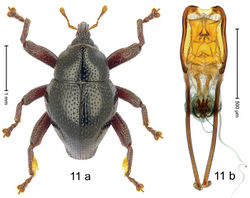Trigonopterus barbipes
| Notice: | This page is derived from the original publication listed below, whose author(s) should always be credited. Further contributors may edit and improve the content of this page and, consequently, need to be credited as well (see page history). Any assessment of factual correctness requires a careful review of the original article as well as of subsequent contributions.
If you are uncertain whether your planned contribution is correct or not, we suggest that you use the associated discussion page instead of editing the page directly. This page should be cited as follows (rationale):
Citation formats to copy and paste
BibTeX: @article{Riedel2019ZooKeys, RIS/ Endnote: TY - JOUR Wikipedia/ Citizendium: <ref name="Riedel2019ZooKeys">{{Citation See also the citation download page at the journal. |
Ordo: Coleoptera
Familia: Curculionidae
Genus: Trigonopterus
Name
Trigonopterus barbipes Riedel sp. n. – Wikispecies link – ZooBank link – Pensoft Profile
Diagnostic description
Holotype, male (Fig. 11a). Length 2.65 mm. Color of antennae and legs ferruginous; remainder black. Body subovate; in dorsal aspect with distinct constriction between pronotum and elytron; in profile with weak constriction. Rostrum dorsally with median costa and pair of submedian ridges; intervening furrows each with row of suberect scales; apical 1/3 punctate-rugose, with indistinct epistome. Pronotum with weak subapical constriction; disk densely punctate; interspaces between punctures subglabrous; indistinct lateral edges more densely punctate, median line impunctate. Elytra irregularly punctate; some striae marked by hardly visible hairlines; basal margin bordered by denser punctures; stria 8 along humerus with six large, coarse punctures. Femora edentate; anteroventral ridge of mesofemur and metafemur crenate; anterior surface of metafemur coarsely punctate, each puncture with subrecumbent silvery scale. Metafemur subapically with stridulatory patch. Metatibia near middle with dense, beard-like cluster of long setae; subapically ventral surface subglabrous, lined by setose fringes. Abdominal ventrites 1–2 concave, punctate, with sparse suberect lanceolate scales; ventrite 5 with distinct, round depression, with suberect lanceolate scales. Penis (Fig. 11b) with sides weakly sinuate; apex with median notch, without setae; apodemes 1.7 × as long as body of penis; transfer apparatus complex; ductus ejaculatorius with indistinct bulbus. Intraspecific variation. Length 2.50–2.65 mm.
Material examined
Holotype (MZB): ARC3048 (GenBank # MK260526), S-Sulawesi Prov., Tanah Toraja, Bittuang, Gn. Ponding, 02°56.446'S 119°38.075'E, 1625 m, beaten, 09-V-2013. Paratypes (MZB, SMNK): 2 exx, ARC3047 (EMBL # LN884953), ARC3049 (GenBank # MK260525), same data as holotype.
Distribution
S-Sulawesi Prov. (Tanah Toraja). Elevation ca. 1625 m.
Biology
On foliage in montane forests.
Etymology
This epithet is a combination of the Latin nouns barba (beard) and pes (foot). It refers to the setose metatibia. Invariable.
Notes
Trigonopterus barbipes Riedel, sp. n. was coded as “Trigonopterus sp. 505”.
Original Description
- Riedel, A; Narakusumo, R; 2019: One hundred and three new species of Trigonopterus weevils from Sulawesi ZooKeys, (828): 1-153. doi
Images
|
